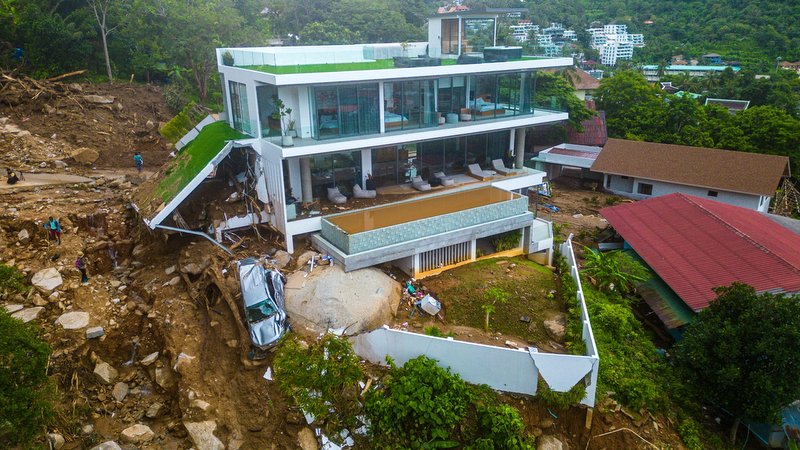“Construction activities are considered a significant factor contributing to the devastating impact of the landslide,” Mr Sopon told The Phuket News.
“Imagine the vibrations caused by a moving car… Now amplify that by the weight of heavy machinery, digging and building. These actions destabilise the soil, making landslides more likely and more destructive,” he explained.
The location of the landslide, behind Wat Kata, was not even on DDPM Phuket’s list of areas at risk of landslides or flooding, Mr Sopon admitted.
“I admit that Karon was overlooked as a potential landslide risk, with our initial focus solely on Kamala,” he said.
“The landscape has changed significantly over the years, with a rise in housing developments and construction activities. I believe this is a critical issue that needs to be addressed,” Mr Sopon noted.
However, Mr Sopon argued the cause of the landslide was not solely construction, but a combination of factors, not least of which was the 200 millilitres of rainfall that fell on the area in a period of about six hours.
“A large amount of rainfall in a short period caused the soil to absorb excess moisture, leading to its collapse… When intense rain falls in a short time, it can trigger landslides,” Mr Sopon said plainly.
“Also, the area has a steep slope combined with rocky terrain, which increases the risk of erosion and makes the ground more slippery and unstable. As a result, the environmental factors also play a significant role in increasing the landslide risk in the area,” he added.
Mr Sopon specifically highlighted the areas of Karon, Kamala and the Khao Phanthurat hills at the western fringes of Koh Kaew as areas at risk of landslides during any potentially similar heavy downpours.
“We will focus on issuing clear warnings through various channels, including warning notices, a LINE group, village headmen and public news updates to ensure the information reaches everyone effectively,” Mr Sopon said.
Phuket MP Chalermpong Saengdee told The Phuket News, "In my opinion, the landslide was caused by a combination of natural disasters and human activities, particularly construction.
"Regarding the incident in Karon, I am currently meeting with the Ministry of Interior, the Department of Disaster Prevention and Mitigation, and other relevant agencies to determine the true cause of this flood and the factors that led to the fatalities,” he said.
"It appears that construction may have contributed to the problem. Many projects were carried out without proper permits or consultation with qualified engineers,” Mr Chalermpong noted.
"These constructions were not adequately inspected or planned, leading to issues like blocked water flow, which can cause houses to collapse or obstruct waterways," he added.
"My main focus right now is on taking preventive and corrective actions. We’re visiting the affected areas to clear and organise water channels to ensure water flows smoothly, which is what we’re currently doing on the ground.
"Secondly, we’ll restore areas that are blocking the water flow by revoking them and returning the land to its natural forest state,” he said.
"Third, we’ll implement measures to increase warning levels in high-risk areas. This will help ensure that residents receive timely alerts and can prepare for evacuation or stay informed about potential flooding," Mr Chalermpong concluded.








